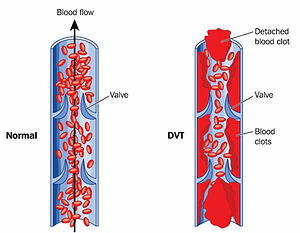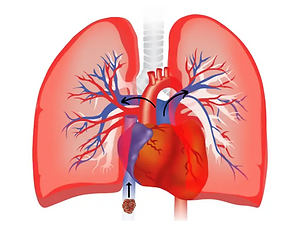D-dimer 101: What is D-dimer?
D-dimer is a small protein fragment made when a blood clot dissolves in your body. The level of D-dimer in your blood can rise greatly when there is significant formation and breakdown of blood clots in your body.
Having a high D-dimer level in your blood is not normal. It can be a be a sign of blood clotting disorder.

D-dimer test: What is it for?
A D-dimer blood test is used to check for blood clotting problems, these include:

Deep vein thrombosis (DVT)
Occurs when blood clots develop in veins deep in your body, usually the leg. DVT itself is not life-threatening but has the potential to develop into a pulmonary embolism (PE) when blood clots break free and travel through your bloodstream.

Pulmonary embolism (PE)
Happens when travelling blood clots become lodged in the blood vessels of your lung. This can be a life-threatening condition.
Other factors associated with a positive or elevated D-dimer result are:
-
Advanced age
-
Malignancy
-
Trauma
-
Pregnancy
-
Heart disease
-
Recent surgery
-
Recovery from COVID-19
Why do I need a D-dimer test?
You may need a D-dimer test if you have symptoms of blood clotting disorders, such as deep vein thrombosis (DVT) or pulmonary embolism (PE).
Symptoms of DVT:
-
Leg swelling
-
Leg pain, cramping or soreness in the calf
-
Change in skin color on the leg
-
A feeling of warmth on the affected leg
Symptoms of PE:
-
Shortness of breath
-
Chest pain
-
Fainting
If you think you have DVT or PE, arrange an urgent appointment with a vascular specialist now, or WhatsApp us.
Do I need a treatment?
If the cause of a high D-dimer level is blood clotting problems, you may need treatment after confirmation by imaging such as ultrasound or CT.
Treatments for DVT:
-
Blood thinners (aka anticoagulants). A type of medicine that may be taken by mouth or given by IV to prevent blood clots from forming.
-
Keyhole removal of blood clot on the leg and arm by percutaneous catheter. A procedure involves inserting a thin, flexible tube (catheter) into a blood vessel through a small puncture in the skin to remove blood clots.
Treatments for PE:
-
Blood thinners (aka anticoagulants). A type of medicine that may be taken by mouth or given by IV to prevent blood clots from forming.
-
Clot busters. A type of heart medication given by IV to break up blood clots.
-
Removal of blood clot with thrombectomy. A surgical or interventional treatment to remove blood clots in an artery or vein.
-
Inferior vena cava (IVC) filter placement. Placement of a small, wiry device (IVC filter) into the major vein that brings oxygen-poor blood from the lower body back to the heart (inferior vena cava, IVC) to catch blood clots and stop them from moving up to the heart and lungs.
Not sure what kind of treatment is suitable for your condition? Thinking of getting quality treatment in Singapore for DVT or PE?
Ulink Assist can make appointments with leading vascular specialists in Singapore on your behalf! Translation during the appointment is available.

